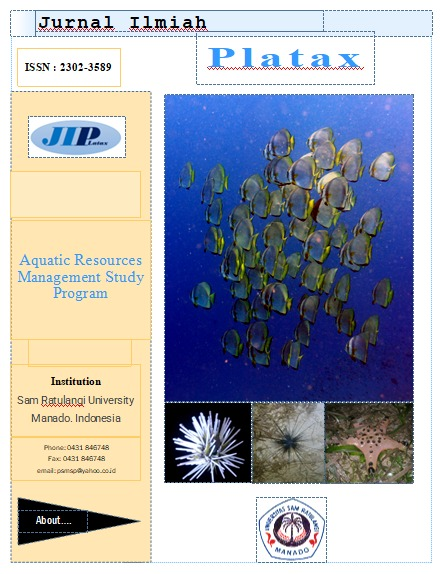Identification of Bioactive Compounds and Antibacterial Activity of Sea Cucumber, Holothuria (Halodeima) atra Jaeger 1833 Flesh Extract from Kalasey Coastal Waters, Minahasa District
DOI:
https://doi.org/10.35800/jip.v10i2.42271Keywords:
Sea cucumber (H.atra), Disc diffusion, Zoo-chemical, ExtractionAbstract
Sea cucumbers are one of the marine biotas that contain bioactive compounds that have the potential as antibacterial ingredients. The purpose of this study was to perform antibacterial testing on fractions of the extract of the sea cucumber H. atra meat and to conduct a zoochemical analysis to determine the content of bioactive compounds that can inhibit bacterial growth. Antibacterial testing using disc diffusion method against Staphylococcus aureus and Escherichia coli bacteria. The results showed that the methanol extract of sea cucumber flesh could inhibit the growth of both types of test bacteria. In antibacterial testing for S. aureus, the ethyl acetate fraction was 11.8 mm, the n-hexane fraction was 7 mm, and the methanol fraction was 8.6 mm, while for E. coli the ethyl acetate fraction was 10.88 mm, the n-hexane fraction was 7 mm, and 8.6 mm methanol fraction. The compounds contained in the ethyl acetate fraction of sea cucumber H. atra flesh extract are alkaloids, flavonoids, steroids, and saponins which are compounds that can inhibit bacterial growth with their respective working mechanisms.
Keywords: Disc diffusion, Extraction, Fractionation, Sea cucumber (H.atra), Zoo-chemical,
Abstrak
Teripang merupakan salah satu biota laut yang memiliki kandungan senyawa bioaktif yang berpotensi sebagai bahan antibakteri. Tujuan penelitian ini melakukan pengujian antibakteri pada fraksi-fraksi dari ekstrak daging teripang H. atra dan melakukan analisis zookimia untuk mengetahui kandungan senyawa bioaktif yang dapat menghambat pertumbuhan bakteri. Pengujian antibakteri menggunakan metode difusi cakram terhadap bakteri Staphylococcus aureus dan Escherichia coli. Hasil penelitian menunjukkan bahwa ekstrak metanol daging teripang memiliki dapat menghambat pertumbuhan kedua jenis bakteri uji. Pengujian antibakteri terhadap S. aureus fraksi etil asetat sebesar 11,8 mm, fraksi n-heksan 7 mm, dan fraksi metanol 8,6 mm sedangkan untuk bakteri E. coli fraksi etil asetat sebesar 10,88 mm, fraksi n heksana 7 mm, dan fraksi metanol 8,6 mm. Kandungan senyawa yang yang terkandung dalam fraksi etil asetat ekstrak daging teripang H. atra yaitu senyawa alkaloid, flavonoid, steroid, dan saponin yang merupakan senyawa yang dapat menghambat pertumbuhan bakteri dengan mekanisme kerja masing-masing.
Kata Kunci : Difusi cakram, Ekstraksi, Fraksinasi , Teripang (H. atra), Zoo-kimia,References
Bordbar, S., F. Anwar., & N. Saari. (2011). High-Value Components and Bioactives From Sea Cucumber for Functional Food – A Review. Mar Drugs, 9, 1761-1805.
David, W. W.,& T. R. Stout. (1971). Disc Plate Method of Microbiological Assay. Journal of Microbiology, 22, 659-665.
Dwicahyani, T. S., & S. L. Rianingsih. (2018). Uji Bioaktivitas Ekstrak Teripang Keling Holothuria atra Sebagai Antibakteri Staphylococcus aureus dan Escherichia coli. J. Peng & Biotek Pi, 7(1), 15-24.
Hossain, A., D. Dave., & F. Shahid. (2020). Northen Sea Cucumber (Cucumaria Frondosa): A Potential Candidate for Functional Food, Nutraceutical, and Pharmaceutical Sector. Mar. Drugs. 18(5):274,27pp.
Kano, N. N., F. Losung., R. Mangindaan., R. Lintang., S. Wulur., & R. Tumbol. (2022). Aktivitas Antibakteri Dari Teripang Laut Yang Di Peroleh Di Perairan Bunaken. Jurnal Pesisir dan Laut Tropis, 10(1), 95-101.
Leba, M. A. U. (2017). Ekstraksi dan Real Kromatografi. Yogyakarta : Deepublish.
Mahmudah, R., A. Mu'nisa., & R. Ngitung. (2019). Identifikasi Senyawa Bioaktif Ekstrak Teripang Hitam (Holothuria edulis). Prosiding Seminar Nasional Biologi VI, 609-613.
Martiningsih, N. (2014). Skrining Awal Ekstrak Etil Asetat Spon Dysidea sp. Universitas Penididikan: Universitas Pendidikan.
Novard, M. F. A., N. Suharti., & R. Rasyid. (2019). Gambaran Bakteri Penyebab Infeksi Pada Anak Berdasarkan Jenis Spesimen dan Pola Resistensinya di Laboratorium RSUD Dr. Djamil Pada Tahun 2014-2016. Jurnal Kesehatan Andalas, 8(2), 26-32.
Purcell, S. W., Y. Samyn., & C. Conand. (2012). Commercially Important Sea Cucumber of The Word. Rome: Food and Agriculture Organization of The United Nations.
Rasyid, A. (2012). Identifikasi Senyawa Metabolit Sekunder Serta Uji Aktivitas Antibakteri dan Antioksidan Ekstrak Metanol Teripang Stichopus hermani. Ilmu dan Teknologi Kelautan Tropis, 4(2), 360-368.
Ritan, Y. E. H., D. S. Wewengkang., & J. P. Siampa. (2021). Uji Antibakteri Ekstrak dan Fraksi Alga Caulerpa racemose Dari Perairan Pulau Mantehage Minahasa Utara Terhadap Pertumbuhan Bakteri Staphylococcus aureus dan Escherichia coli. PHARMACON, 10(2), 905-911.
Setyastuti, A., I. Wirawati., & M. Y. Iswari. (2018). Identification and Distribution of Sea Cucumber Exploited in Lampung Indonesia. Biodiversitas, 19(2), 726-732.
Shaikh, J. R. (2020). Qualitative test for preliminary phytochemical screening an overview. International Journal of Chemical Studies, 603-808.
Umboh, P. M. T., D. S. Wewengkang., & P. V. Y. Yamlean. (2018). Aktivitas Antibakteri Fraksi Teripang Laut Holothuria atra Terhadap bakteri Escherichia coli dan Staphylococccus aureus. Pharmacon, 7(4), 88-97.
Wildati, A. N. (2019). Diversitas Holothuroidea Berdasarkan Karakteristik Morfologis Di Perairan Pantai Utara Jawa Timur dan Pulau Mandangin Madura. Surabaya: Jurusan Sains Fakultas Sains dan Teknologi Universitas Islam Negeri Sunan Ampel.
WoRMS. Holothuria (Halodeima) atra Jaeger 1833. Diakses di: https://www.marinespecies.org/aphia.php?p=taxdetails&id=148748 pada 19 Juli 2022.
Downloads
Published
How to Cite
Issue
Section
License
COPYRIGHT
Authors who publish with this journal agree to the following terms:
Authors hold their copyright and grant this journal the privilege of first publication, with the work simultaneously licensed under a Creative Commons Attribution License that permits others to impart the work with an acknowledgment of the work's origin and initial publication by this journal.
Authors can enter into separate or additional contractual arrangements for the non-exclusive distribution of the journal's published version of the work (for example, post it to an institutional repository or publish it in a book), with an acknowledgment of its underlying publication in this journal.
Authors are permitted and encouraged to post their work online (for example, in institutional repositories or on their website) as it can lead to productive exchanges, as well as earlier and greater citation of the published work (See The Effect of Open Access).




















